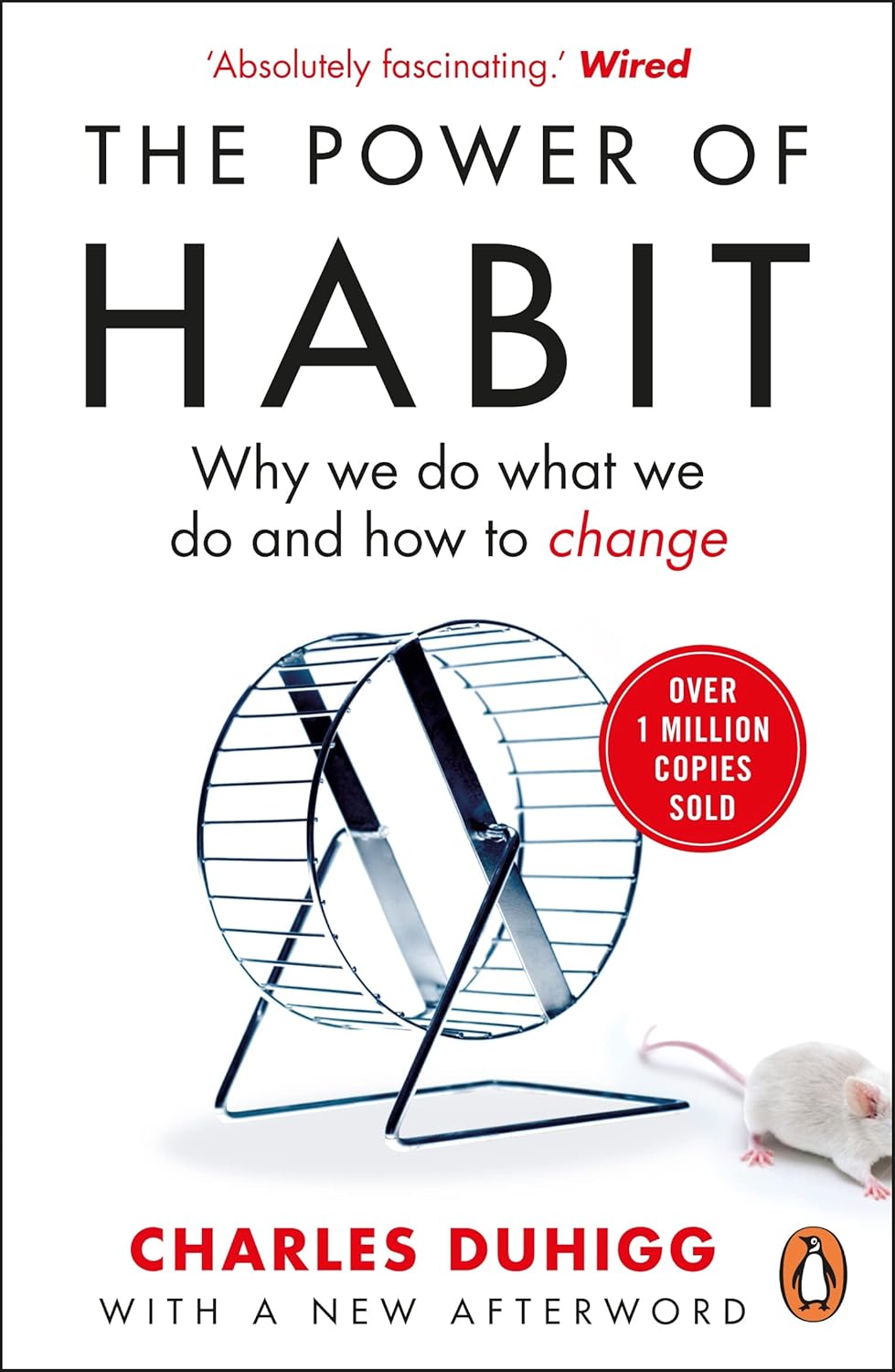Build Better Habits Tools and Resources

...solve thorny business challenges in the time it takes to drink a cup of tea
Can you transform the success of your business by unlocking the power of habit change?

©Freepik
Can you really change the fortunes of your business simply by changing a few small habits?
The answer is, of course, yes. It requires focus, discipline, and a determination to be better than yesterday, but it can be done.
Whether it’s how your team works together, the way you handle day-to-day tasks, or how you make key decisions, habits play a significant role in how your business runs.
By recognising and changing the patterns that hold you back, and by replacing bad habits with good habits, you can boost productivity, minimise challenges and stress, and make real progress towards your goals. Small shifts in behaviour can lead to big changes in business success.
So, think about your business and ask yourself this one key question:
How can I replace bad habits with good ones to maximise the success of my business?
STOP thinking that just because something has always been done one way it cannot be changed
START investing time, effort and energy into making small steps towards changing the habits in your business
The one ‘BREAKTHROUGH QUESTION’ you must ask to help yourself…
How can I replace bad habits with good ones to maximise the success of my business?
Imagine starting each day, not with stress or uncertainty, but with positive momentum and a clear sense of progress.
What if, instead of reacting to chaos, you built routines that moved your business forward, step by step, every single day?
Habit change isn’t just a personal development tool; it’s a strategic lever and can be a competitive advantage.
When small, purposeful behaviours are repeated consistently, they create systems that drive growth, sharpen focus, and transform disorder into direction.
What this means is that you CAN change the way things are done in your business, even if they have been done a certain way over a long period of time.
The question above is one every ambitious business owner should be asking themselves. Often, it’s not a lack of effort or vision that holds a business back, but the day-to-day routines and patterns that go unnoticed.
From the pointless, inefficient meetings to the rushed and reactive decision-making, these ingrained behaviours can quietly limit growth and performance.
The good news is that bad habits aren’t permanent and can be replaced by good ones.
When you identify and understand the bad habits and intentionally replace them with good ones, you create a stronger foundation for long-term success.
In these tools, we will provide some practical tips, worksheets, and steps you can use with your team to embed new habits in your business, using the research, wisdom and books of Charles Duhigg and James Clear.
The Habit Loop and 5 Habit Triggers (from Charles Duhigg's book, The Power of Habit)
“Change might not be fast and it isn’t always easy. But with time and effort, almost any habit can be reshaped.” – Charles Duhigg, Supercommunicators: How to Unlock the Secret Language of Connection
In The Power of Habit by Charles Duhigg, he explains that every habit functions as a loop made up of three components. The Habit Loop consists of:
Cue (Trigger) – what initiates the habit
Routine – the behaviour itself (the habit you perform)
Reward – what you gain from the behaviour (the brain’s reason for repeating it)

However, Duhigg expands on the cue by noting that most triggers fall into one of five categories:
- Location – Where are you?
- Time – What time is it?
- Emotional state – How are you feeling?
- Other people – Who else is around?
- Immediately preceding action – What did you just do?
These categories help you identify the cue that’s driving a habit, which is the first step toward changing it.
How to re-direct your autopilot – change the habit (from Charles Duhigg's book, The Power of Habit)
“The truth is, the brain can be reprogrammed. You just have to be deliberate about it. Habits aren’t destiny.” — Charles Duhigg, The Power of Habit
Charles Duhigg outlines a 4-step process for changing habits:
1. Identify the Routine
Pinpoint the behaviour you want to change – the “autopilot” action.
2. Experiment with Rewards
Try different rewards to understand what craving the habit is satisfying; for example, is your afternoon cookie run about hunger or boredom, or is it a social break?
3. Isolate the Cue
Use the 5 categories noted above to find the trigger. What consistently leads to the routine?
4. Have a Plan
Once you have identified the cue and the reward, create a new routine that delivers the same reward when the cue arises.
This is called a “habit replacement” strategy.
Example:
- Cue: 3 pm (time)
- Routine: Walk to the cafeteria and buy a cookie
- Reward: Mental break and chance to chat with colleagues
New plan: At 3pm, take a quick walk to a friend’s desk to chat for 10 minutes. You get the same reward (social break) without the cookie.
In the resources below, you will find a worksheet template that you can use with your team to start the habit change process using Charles Duhigg’s framework.
1% can make a difference (adapted from James Clear's book, Atomic Habits)
“You do not rise to the level of your goals. You fall to the level of your systems.” — James Clear, Atomic Habits
James Clear’s book, Atomic Habits, is centred around the idea that small, consistent changes lead to remarkable results, but the real power of habit change comes from shifting your identity, not just your actions.
Clear argues that habits compound like interest. If you improve 1% each day, over time, those improvements lead to massive transformation.
But the key to lasting change is not simply focusing on goals, but on becoming the type of person who can sustain the behaviours. That means building habits that reinforce the identity you want to embody.
These ‘laws' are the backbone of Atomic Habits. Each law helps you build a good habit, and its inverse helps you break a bad one.
Law | Build a Good Habit | Break a Bad Habit |
|---|---|---|
1. Cue | Make it obvious | Make it invisible |
2. Craving | Make it attractive | Make it unattractive |
3. Response | Make it easy | Make it hard |
4. Reward | Make it satisfying | Make it unsatisfying |
1. Make It Obvious (Cue)
Design your environment to trigger the behaviour.
Use habit stacking: “After I [current habit], I will [new habit].”
Example: After I brush my teeth, I’ll meditate for 2 minutes.
2. Make It Attractive (Craving)
Use temptation bundling: pair a habit you want to form with something you enjoy.
Example: I’ll only watch Netflix while on the treadmill.
3. Make It Easy (Response)Reduce friction.Start with habits so small they feel trivial (Clear calls this the “2-minute rule”).
Example: Read one page, not one chapter.
4. Make It Satisfying (Reward)
Use immediate reinforcement (e.g., check off a habit tracker).
Celebrate the action to reinforce the identity.
Example: Tracking progress gives your brain a reward signal.
Shift from goals to identity (adapted from James Clear's book, Atomic Habits)
“Every action you take is a vote for the type of person you wish to become.” – James Clear
Clear’s biggest insight is that habits stick when they become part of your identity, not just a means to an end.
Old Model: Outcomes-Based
Goal – Process – Identity
“I want to lose 20 pounds.” (goal)
“So I’ll go to the gym.” (process)
“Hopefully I’ll become healthy.” (identity)
New Model: Identity-Based
Identity – Process – Outcome
“I’m a healthy person.” (identity)
“So I go to the gym.” (process)
“As a result, I lose weight.” (outcome)
How to Make the Identity Shift:
Decide the kind of person you want to become.
- Not: “I want to write a book.”
- But: “I’m the kind of person who writes every day.”
Prove it to yourself with small wins.
- Each habit is a vote for the type of person you want to be.
- You don’t need to be perfect, just consistent.
Every time you go for a run, you're proving to yourself: “I’m a runner.”
In the resources below, you will find a worksheet template that you can use with your team to start the habit change process using James Clear’s framework.
The book and other resources
The Power of Habit is a compelling exploration of how habits shape our lives, our businesses, and our societies – and how we can harness their power for positive change.
Drawing on cutting-edge research in neuroscience, psychology, and behavioural science, Duhigg introduces the concept of the “habit loop,” a cycle of cue, routine, and reward that drives automatic behaviour.
Through engaging real-world case studies – from how Febreze became a household name to how Starbucks trains employees to handle stress – he shows how individuals and organisations alike can identify and reshape the patterns that influence performance and decision-making.
Practical, insightful, and widely accessible, the book offers a roadmap for anyone looking to understand how habits work – and, more importantly, how to change them.
What people are saying about this book:
“This is a first-rate book – based on an impressive mass of research, written in a lively style and providing just the right balance of intellectual seriousness with practical advice on how to break our bad habits.” – The Economist
“Few [books] become essential manuals for business and living. The Power of Habit is an exception.” – Andrew Hill, Financial Times
“A fresh examination of how routine behaviours take hold and whether they are susceptible to change … The stories that Duhigg has knitted together are all fascinating in their own right, but take on an added dimension when wedded to his examination of habits.” – Associated Press
Atomic Habits is a practical and insightful guide to breaking bad habits and building better ones by focusing on small, incremental changes. Rather than relying on willpower or motivation alone, Clear emphasises the power of systems, showing how tiny improvements, made consistently over time, can lead to remarkable results.
At the heart of the book is the idea that habits are not just actions, but a reflection of our identity, and by shifting how we see ourselves, we can create lasting behavioural change.
Drawing on research in psychology, neuroscience, and personal development, Clear offers a clear, actionable framework – the Four Laws of Behaviour Change – to help readers design habits that stick. With real-life examples and a conversational style, Atomic Habits is both accessible and deeply transformative for individuals and professionals alike.
What people are saying about this book:
What people are saying about this book:
James Clear’s Atomic Habits is one of the most practical and insightful books on habit formation, offering a science-backed approach to making small changes that lead to big results. With its clear writing, actionable strategies, and real-life examples, this book is a must-read for anyone looking to improve their daily routines, break bad habits, and achieve long-term success. – Forbes
“One of the 17 best books ever written on management and productivity.” – John Rampton, Entrepreneur Magazine
Click the button below for a worksheet template that you can use with your team to start the habit change process using Charles Duhigg’s framework.
Click the button below for a worksheet template that you can use with your team to start the habit change process using James Clear’s framework.
Click the button below to see your personalised Habit Change plan using both Duhiggs and Clears frameworks.
YOUR SUPPORT TOOLS ARE HERE:
Click the button below and you'll be able to download a pdf version of this page.

